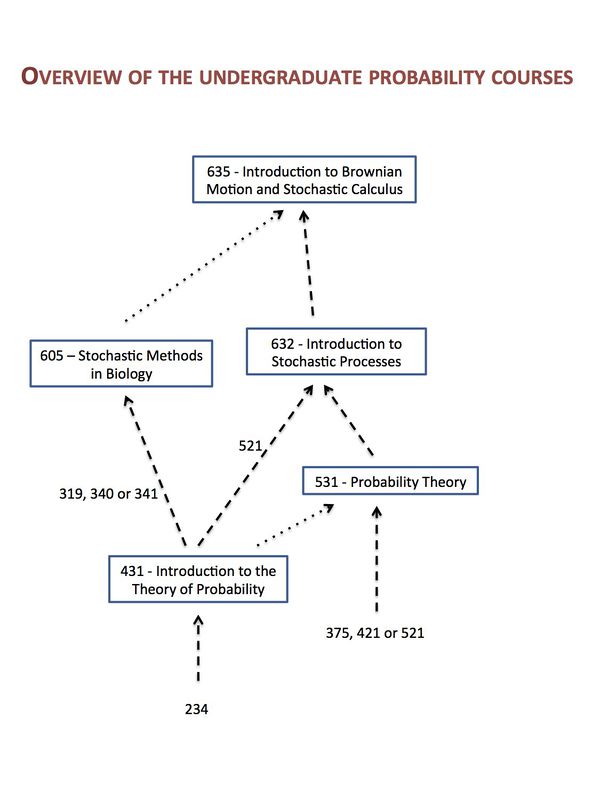Undergraduate courses in probability: Difference between revisions
No edit summary |
No edit summary |
||
| Line 27: | Line 27: | ||
[http://www.math.wisc.edu/math-605stochastic-methods-biology '''605 - Stochastic methods in biology'''] | [http://www.math.wisc.edu/math-605stochastic-methods-biology '''605 - Stochastic methods in biology'''] | ||
Math 605 provides an introduction to stochastic processes. It introduces both discrete and continuous time Markov chains, and some aspects of renewal theory. The course focuses on biological applications of these mathematical models including: the Wright-Fischer model, birth and death processes, branching processes, and many models from intracellular biochemistry. This course is similar to Math 632 in content. However, unlike Math 632 simulation plays a vital role in the study of the requisite processes in Math 605, with Matlab the software package of choice. | Math 605 provides an introduction to stochastic processes. It introduces both discrete and continuous time Markov chains, and some aspects of renewal theory. The course focuses on biological applications of these mathematical models including: the Wright-Fischer model, birth and death processes, branching processes, and many models from intracellular biochemistry. This course is similar to Math 632 in content. However, unlike in Math 632, simulation plays a vital role in the study of the requisite processes in Math 605, with Matlab the software package of choice. | ||
The course is offered every two years in the fall semester. | The course is offered every two years in the fall semester. | ||
Revision as of 17:02, 28 August 2014
431 - Introduction to the theory of probability
Math 431 is an introduction to probability theory, the part of mathematics that studies random phenomena. We model simple random experiments mathematically and learn techniques for studying these models. Topics covered include methods of counting (combinatorics), axioms of probability, random variables, the most important discrete and continuous probability distributions, expectations, moment generating functions, conditional probability and conditional expectations, multivariate distributions, Markov's and Chebyshev's inequalities, laws of large numbers, and the central limit theorem.
Probability theory is ubiquitous in natural science, social science and engineering, so this course can be valuable in conjunction with many different majors. 431 is not a course in statistics. Statistics is a discipline mainly concerned with analyzing and representing data. Probability theory forms the mathematical foundation of statistics, but the two disciplines are separate.
The course is offered every semester, including the summer.
Prerequisite: Math 234.
Who should take this class? A well rounded undergraduate experience in math should include some probability theory. Math 431 is our introductory probability class with no high level prerequisites.
531 - Probability theory
The course is a rigorous introduction to probability theory on an advanced undergraduate level. Only a minimal amount of measure theory is used (in particular, Lebesgue integrals will not be needed). The course gives an introduction to the basics (Kolmogorov axioms, conditional probability and independence, random variables, expectation) and discusses some of the classical results of probability theory with proofs (DeMoivre-Laplace limit theorems, the study of simple random walk on Z, applications of generating functions).
This course is currently in development. The pilot version of the course will run in the Spring 2015 semester as 491a - Topics : Probability Theory.
Prerequisite: a proof based analysis course (Math 375, Math 421 or Math 521).
Who should take this class? Students who would like to get a rigorous introduction to probability. It could also provide a stepping stone for our 600 level stochastic processes courses. (The course can be taken even after taking Math 431.)
605 - Stochastic methods in biology
Math 605 provides an introduction to stochastic processes. It introduces both discrete and continuous time Markov chains, and some aspects of renewal theory. The course focuses on biological applications of these mathematical models including: the Wright-Fischer model, birth and death processes, branching processes, and many models from intracellular biochemistry. This course is similar to Math 632 in content. However, unlike in Math 632, simulation plays a vital role in the study of the requisite processes in Math 605, with Matlab the software package of choice.
The course is offered every two years in the fall semester.
Prerequisite: Math 431, a basic knowledge of linear algebra and linear differential equations (e.g. Math 319, Math 340, Math 341)
Who should take this class? Anybody who is interested in stochastic processes and would like to learn more about applications in the biosciences, and especially intracellular biochemical processes.
632 - Introduction to stochastic processes
Math 632 gives an introduction to Markov chains and Markov processes with discrete state spaces and their applications. Particular models studied include birth-death chains, queuing models, random walks and branching processes. Selected topics from renewal theory, martingales, and Brownian motion are also included, but vary from semester to semester to meet the needs of different audiences.
Prerequisite: Math 431, a high level math course (e.g. Math 521)
Who should take this class? Math 632 is the natural next step after an introductory probability course. It could be useful for an Option 1 math major interested in higher level probability and it is also a great fit for many of our Option 2 packages.
635 - Introduction to Brownian motion and stochastic calculus
Math 635 is an introduction to Brownian motion and stochastic calculus without a measure theory prerequisite. Topics touched upon include sample path properties of Brownian motion, Itô stochastic integrals, Itô's formula, stochastic differential equations and their solutions. As an application we will discuss the Black-Scholes formula of mathematical finance.
The course is offered every two years in the spring semester.
Prerequisite: Math 521 and Math 632
Who should take this class? Anybody with an interest in higher level probability. It is especially useful for those who are planning to study financial math on a graduate level.
